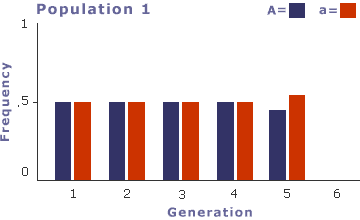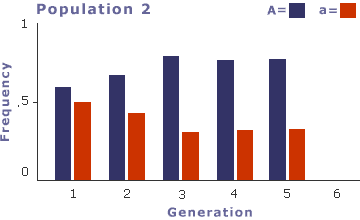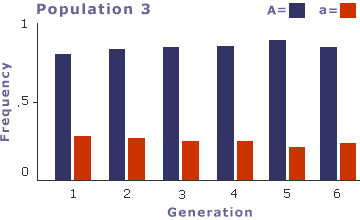|
In Ms. Havlik's idealized simulated population (Population One), students all began with heterozygous genotypes (Aa). That imaginary population reached the Hardy-Weinberg equilibrium in one generation and did not shift significantly in subsequent generations.

Then the simulation began to explore what would happen to allele frequencies in two subsequent populations, where evolutionary forces were in play.
In the second round of mating (Population Two), the homozygous recessive genotype (aa) was at a disadvantage and died. In order to keep the size of the population constant, each pair of students was instructed to continue mating their populations until they produced two and only two living offspring. This resulted in a shift of genotype frequencies within the population and, therefore, evolution of the population by natural selection.

In the next round (Population Three), the simulation demonstrated what would happen if the heterozygous genotype (Aa) was at an advantage and the homozygous dominant genotype (AA) had only a 50-50 chance of survival. Again, in this situation the frequency of genotypes shifted from the equilibrium state to reflect the effect of natural selection on genotypes (expressed as phenotypes) in the population.

This situation represented balanced polymorphism -- a heterozygous genotype confers an advantage over the homozygous condition. This allows a deleterious recessive allele to remain in a population-because the heteozygous genotype has an advantage and contains one recessive allelle.
Ms. Havlik then helped students connect their simulation to a real-world application based on an earlier reading. Homozygous recessive genotype is responsible for sickle cell anemia in individuals, but balanced polymorphism (heterozygosity) protects against malaria, an often fatal disease present in areas of Africa. The homozygous dominant does not protect against malaria, so therefore heterozygosity is favored. The classroom simulation also demonstrated the advantages of balanced polymorphism (heterozygosity) and showed that evolution occurs at the level of populations, not individuals.
For a variation on this lab, see the University of Michigan Web site Establishing Hardy-Weinberg Equilibrium.
|